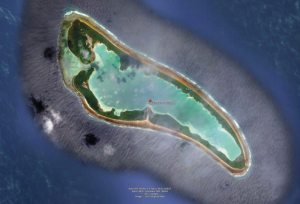Or “How are things in Nikumaroro?”
By Edita McQuary

About 25 years ago The International Group for Historic Aircraft Recovery (TIGHAR) began to scientifically investigate the disappearance. A member of TIGHAR, Senior Archeologist Dr. Thomas King, has led trips to the likely area of disappearance, an atoll called Nikumaroro Island (formerly known as Gardner Island), and now a part of the Republic of Kiribati.
Dr. King graduated from the University of California – Riverside with a PhD in anthropology, and is a close friend of retired Cabrillo College archeology department head, Rob Edwards. He is a founding member and past president of the Society for California Archeology. He has extensive archeological field experience in California and Micronesia. He was an archeologist for the U.S. Trust Territories of the Pacific Islands and head of archeological surveys at three universities and has written several textbooks and trade books.
He and his team have researched records in the South Pacific, in England (because the British had control of the island during World War II), and in the United States to come up with some very interesting discoveries. Dr. King said there are three main hypotheses: they crashed at sea; they were captured by the Japanese military and died; or they landed on Nikumaroro. From the evidence found by TIGHAR, the last seems to be the most plausible.
TIGHAR has done archeological studies on Nikumaroro in 2001, 2007, 2010 and 2015. Their work has “produced data suggestive of visitors from the 1930’s, including cosmetic bottles, a small ointment pot, a zipper, and the mirror from a compact.” All of these appeared to be American-made. On another site on the island, in 1991 TIGHAR found parts of a woman’s shoe as well as a man’s shoe. “The woman’s shoe was identified as a “Blucher-style oxford” dating to the 1930’s (a style Amelia wore on her flight).”
From a photograph of the Electra’s take off from nearby Lae Island, the hypothesis is that the airplane may have had its undercarriage damaged and needed to land nearby on Nikumaroro Island. Later, in 1940 while the British controlled the island, their records indicate the discovery of a human cranium and a total of 13 bones, which were shipped to Suva and in true mystery fashion, disappeared.
In 2017, on the 80th anniversary of Amelia’s world flight and disappearance, Dr. King and his archeological survey team are sailing to Nikumaroro on June 21 through July 11, 2017 on board the “Reef Endeavour” to undertake further studies on the island. They invite interested persons to join them. The area they are visiting has the largest marine sanctuary in the world and has untouched coral reefs. There will be opportunities for swimming, snorkeling, kayaking, and scuba diving at Niku, as he fondly calls Nikumaroro.
•••
For further information on the Nikumaroro hypothesis and TIGHAR’s work, visit tighar.org. For information about the Santa Cruz Archeology Society, see www.santacruzarchsociety.org. For the voyage to Nikumaroro, contact Betchart Expeditions, Inc. at Marisa@betchartexpeditions.com.